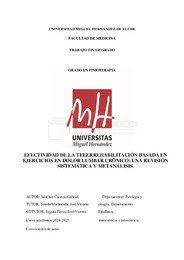Please use this identifier to cite or link to this item:
https://hdl.handle.net/11000/37598Full metadata record
| DC Field | Value | Language |
|---|---|---|
| dc.contributor.advisor | Toledo Marhuenda, José Vicente | - |
| dc.contributor.advisor | Segura Heras, José Vicente | - |
| dc.contributor.author | Sánchez Cuenca, Gabriel | - |
| dc.contributor.other | Departamentos de la UMH::Patología y Cirugía | es_ES |
| dc.contributor.other | Departamentos de la UMH::Estadística, Matemáticas e Informática | es_ES |
| dc.date.accessioned | 2025-10-01T09:30:19Z | - |
| dc.date.available | 2025-10-01T09:30:19Z | - |
| dc.date.created | 2025-05-27 | - |
| dc.identifier.uri | https://hdl.handle.net/11000/37598 | - |
| dc.description.abstract | Introducción: el dolor lumbar crónico es una de las patologías más frecuentes a nivel musculoesquelético en todo el mundo, acarreando gastos importantes en el sistema sanitario. Los tratamientos activos, como el ejercicio terapéutico, son considerados como de primera línea. Con la pandemia, se han incorporado muchas innovaciones digitales donde la telerrehabilitación ha crecido y sigue evolucionando, presentándose como una alternativa al tratamiento convencional. Métodos: se realizaron búsquedas en las bases de datos PUBMED y EMBASE de ensayos controlados aleatorios en los que al menos un grupo recibió telerrehabiltación basada en ejercicios (TRHB-E). La calidad metodológica y el riesgo de sesgo se evaluaron mediante PEDro y Cochrane, respectivamente. Resultados: se incluyeron 15 estudios para el análisis cualitativo y 11 estudios para el cuantitativo. El tamaño de muestra total fue de 1342 participantes con dolor lumbar crónico (DLC). Se analizaron las variables, dolor, discapacidad, catastrofismo y kinesiofobia. Se observaron diferencias estadísticamente significativas (p<0.05) en todas las variables anteriormente mencionadas después de la TRHB-E en comparación con una intervención de fisioterapia en clínica basada en ejercicios, fisioterapia convencional o consejos educativos en todos los periodos de tiempo. Conclusión: se sugiere la TRHB-E es igual de efectiva para disminuir el dolor y la discapacidad como otras intervenciones presenciales o mínimas en pacientes con dolor lumbar crónico. Sin embargo, respecto al catastrofismo y la kinesiofobia la evidencia es deficiente ya que muy pocos estudios han evaluado esta medida de resultado. | es_ES |
| dc.description.abstract | Introduction: Chronic low back pain is one of the most common musculoskeletal conditions worldwide, resulting in significant healthcare expenditures. Active treatments, such as therapeutic exercise, are considered first-line. With the pandemic, many digital innovations have been incorporated, and telerehabilitation has grown and continues to evolve, presenting itself as an alternative to conventional treatment. Methods: PUBMED and EMBASE databases were searched for randomized controlled trials in which at least one group received exercise-based telerehabilitation(E-TRHB). Methodological quality and risk of bias were assessed using PEDro and Cochrane, respectively. Results: Fifteen studies were included for qualitative analysis and 11 for quantitative analysis. The total sample size was 1342 participants with chronic low back pain (CLBP). The variables analyzed were pain, disability, catastrophizing, and kinesiophobia. Statistically significant differences (p<0.05) were observed in all of the aforementioned variables after E-TRHB compared with an in-clinic exercise-based physical therapy intervention, conventional physical therapy, or educational counseling at all time periods. Conclusion: It is suggested that E-TRHB is equally effective in reducing pain and disability as other in-person or minimal interventions in patients with chronic low back pain. However, regarding catastrophizing and kinesiophobia, the evidence is lacking as very few studies have evaluated this outcome measure. | es_ES |
| dc.format | application/pdf | es_ES |
| dc.format.extent | 76 | es_ES |
| dc.language.iso | spa | es_ES |
| dc.publisher | Universidad Miguel Hernández | es_ES |
| dc.rights | info:eu-repo/semantics/openAccess | es_ES |
| dc.rights | Attribution-NonCommercial-NoDerivatives 4.0 Internacional | * |
| dc.rights.uri | http://creativecommons.org/licenses/by-nc-nd/4.0/ | * |
| dc.subject | low back pain | es_ES |
| dc.subject | telerehabilitation | es_ES |
| dc.subject | exercise therapy | es_ES |
| dc.subject | exercise | es_ES |
| dc.subject.other | CDU::6 - Ciencias aplicadas | es_ES |
| dc.title | Efectividad de la telerrehabilitación basada en ejercicios en dolor lumbar crónico: una revisión sistemática y metaanálisis. | es_ES |
| dc.type | info:eu-repo/semantics/bachelorThesis | es_ES |

View/Open:
TFG SÁNCHEZ CUENCA,GABRIEL.pdf
5,44 MB
Adobe PDF
Share:
.png)
